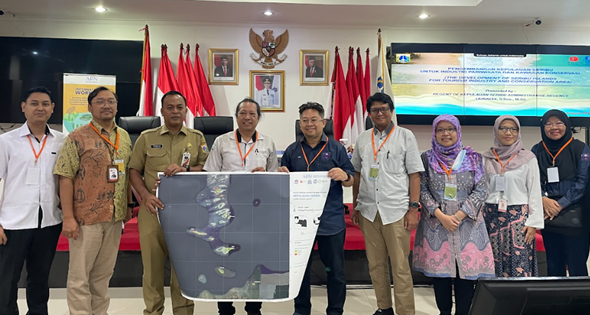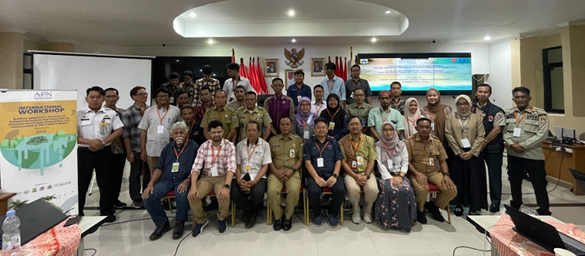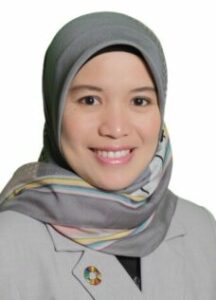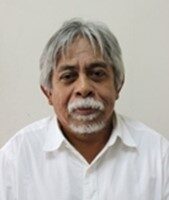Project • CRRP2022-06MY-Muslim
Enhancing coastal risk reduction science and practice by considering climate, ecosystems and communities in the tropical region
Project Leader
Collaborators
INTRODUCTION
Climate change and population growth are severely affecting coastal ecosystems, putting people and infrastructure at risk. In an era of rising oceans, relying on concrete infrastructures shorelines is unsustainable, considering the costs of construction and maintenance and the unforeseen impacts on ecosystems. Particularly for communities whose livelihoods and sustenance are dependent on coastal and marine habitats. Benthic habitat conservation and restoration, including coral reef, seagrass, and mangrove, can be low-cost, long-term shoreline protection options. However, incomplete knowledge on these risks in the long-term perspective that consider multi-interrelated factors in the area, is still not studied up to the present. Furthermore, decision-makers frequently lack fundamental knowledge about where and under what conditions ecosystems lessen the risk of coastal hazards, as well as who might benefit. This proposed study will look at how coral reefs, mangroves, and seagrass reduce risk in some pilot sites under present and future climate scenarios. This project will develop and showcase a framework for spatial risk assessment through the employment of empirical study. This study will contribute to achieving multiple Sustainable Development Goals (SDGs) such as Climate Action (SDG 13), Life Below Water (SGD 14), and Life on Land (SDG 15).
DESCRIPTION OF THE PROPOSED PROJECT
Climate change, particularly its associated sea-level rise and warming effects are a major threat to the coastal marine areas. It has adverse impacts on the functioning of coastal marine ecosystems and provisions of critical goods and services to the coastal communities. The inundation of coastal areas triggers shoreline erosion, declining water quality, decreasing fish cultivation, seawater intrusion, and the inundation of wetlands and estuaries. This impact is much more pronounced to the resource-poor coastal communities as they have limited livelihood options due to remoteness and fragile coastal and small island settings and less incentive to stay in balance with surrounding ecosystems. While climate projections using advanced climate models for different climate scenarios exist, severe impacts on coastal regions, rivers systems, and coastal infrastructures have already been observed, mainly due to coastal area degradation triggered by unmanaged coastal development. Furthermore, benthic habitat conservation and restoration, including coral reef, seagrass, and mangrove, can be low-cost, long-term shoreline protection options. However, incomplete knowledge of these risks in the long term perspective that consider multi interrelated factors in the area, is still not studied up to the present.
Therefore, it is essential to develop science and practice to reduce the risk of coastal hazards due to climate change and natural habitat loss through integrated risk assessment and strategic management planning. The risk assessment concept has been explained in various ways by various experts from different disciplines. In principle, risk has two main dimensions hazard and vulnerability. However, many coastal risk assessments have been conducted based on the characterization only of physical elements which makes integrate quantitative assessments of the future trends of the social-ecological conditions difficult. In this proposed project we will conduct a risk assessment that reflects an increasing need to evaluate the links between the social and ecological dimensions. This proposed study will look at how coral reefs, mangroves, and seagrass reduce risk in some pilot sites under present and future climate scenarios. This project will develop and showcase a framework for spatial risk assessment through the employment of empirical study. Our central idea is that human actions and social structures profoundly influence ecological dynamics, and vice-versa. In our proposed assessment we will consider both physical and community elements suited for the case of the tropical region which also consists of coastal areas and small islands. We will perform a systematic and comprehensive multi-disciplinary approach that balances scientific robustness and credibility with a level of practicality, which enables the results to be undertaken in a short-course type of diverse stakeholders, and whose transparent process can be repeated to assess trends.
CONCISE LITERATURE REVIEW
Globally, an estimated 310 million people and $11 trillion in GDP are vulnerable to the magnitude of a 100- year flood event (Hinkel et al., 2014). Rising sea levels and other climate-related threats, combined with population growth, are also expected to increase risk. A 100-year flood event could affect up to 411 million people by 2060. As a result, developing resilient communities is a shared challenge for the world’s population living along the coast today and in the future (Adger et al., 2005; McGranahan et al., 2007; Kron, 2013). In order to address this issue, communities typically construct barriers along the coast. Traditional approaches to coastal protection, such as seawalls, bulkheads, etc., are becoming increasingly unsustainable ( Gittman et al., 2015; Rangel-Buitrago et al., 2017). Nature-based approaches are widely known as potentially no- or
low-regret coastal adaptation options, regardless of future climate change, because conserving or restoring natural habitats does not preclude subsequent actions. ( Nurse et al., 2014). Conservation and, in some cases, habitat restoration are less expensive than built infrastructure and are highly cost-effective (for example, breakwater construction vs. mangrove restoration) (Narayan et al., 2016). Besides that, coastal ecosystems may adapt to climate change, making them potentially more effective than physical infrastructure in the long run. (Temmerman et al., 2013). These findings are encouraging for the island nation, particularly around South East Asia countries. Strengthening hazard resilience necessitates a better understanding of where ecosystems are most important for coastal protection, especially in light of development threats (Gittman et al., 2015). In this case, a qualitative approach based on expert or stakeholder opinion may be helpful as a medium for the knowledge gap. It can support decision-making more attainable (Heathwaite, 2003).
Therefore, we anticipate that combining a coastal hazard and social vulnerability analysis will result in a step forward in identifying the impacts of coastal habitat loss and climate change as a more commonly used framework by practitioners, facilitating the development of adaptation plans.
RELEVANCE TO APN’S STRATEGIC PLAN
The project will realize the vision and mission of the APN Goals and Action Agenda by providing an understanding on how marine ecosystems reduce the risk along the coastal area under present and future climate scenarios in the tropic. These complex issues are related to the APN research agenda, namely climate, biodiversity and ecosystem, Risk, and Resilience. Our research will perform the analyses and involve experts, local stakeholders, in accordance with APN’s mission. This transdisciplinary and multi- partner research with capacity building multi-stakeholders workshops and a set of two case studies in the Asia-Pacific region has high potential to create a new leading research network in the area of coastal disaster risk reduction under climate change.
This research has relevance to APN goals 1, 2, and 3 through Building a network between four Asian-Pacific organizations located in Indonesia, Malaysia, Japan, and India, organizing regional meetings between researchers, policymaker and local communities, and identifying current and future issues related to coastal risk reduction through transdisciplinary research process [Goal 1], supporting to early-career professionals through tailored research activities [Goal 2] and channeling discussion between scientists and policymakers, through capacity building workshops [Goal 3].
OBJECTIVES AND DELIVERABLES
- To develop a framework and set of methodologies for the spatial risk assessment of coastal risk reduction and practice by considering climate, ecosystem, and communities.
- To develop regional research institutions’ capacity to carry out the process independently or to design a relevant one based on multi-stakeholder collaboration; and deliver capacity-building workshops to local stakeholders and policymakers on how to operationalize these outcomes in the form of adaptation plans.
Expected Outcomes:
Creating an integrated framework for spatial risk assessment method to evaluate the impact of climate and marine ecosystem on coastal risk reduction
Building the adaptation scenario
Collaboration between researchers in Indonesia, Malaysia, Japan, and India, and between local stakeholders and researchers, supported by empirical research.
Deliverables:
Two academic papers are written by the four countries’ collaborators, and published in international peer- reviewed publications (i.e., Journal, books)
Capacity-building workshops for designated country delivered to policymakers, practitioners, and researchers New research network in the area of coastal risk reduction
Homepage for distribution of information and training materials on the framework and method
DESCRIPTION OF THE PROJECT METHODOLOGY
We will develop the coastal risk model to evaluate the risk of coastal hazards to individuals living near the shore as the sea level rises in the future. This is a decision-making tool that employs an index-based method to analyze the relative vulnerability of communities to coastal hazards and identify where habitats have the most significant potential to provide coastal protection (Sharp et al., 2018). The model will account for biophysical, social, and climatic components governing exposure to flooding and inundation from coastal hazards by addressing ecosystems’ ability in providing coastal protection and integrating information about humans, assets, and other related metrics in the framing of risk (e.g., Husnayaen et al., 2018).
Coastal Hazard Index
We will assess the risk of coastal hazards to coastal communities along the coastline under SLR and habitat scenarios. We will use the Coastal Vulnerability model to generate a hazard index that ranks the shoreline’s relative exposure to flooding and erosion based on physical variables such as habitat type and extent, SLR, shoreline type, wave exposure, coastal elevation, etc. The variables listed above were assigned ranks from lowest exposure (class = 1) to highest exposure (class = 5) for each coastal segment based on a combination of absolute and relative rankings of modeled and observed data. The geometric mean of the ranked variables (where R = rank and all variables were given equal weighting) was used to calculate the final coastal hazard index. The results will show the relative exposure to flood and erosion hazards for each coastal segment compared to other features across all SLR and habitat scenarios.
To map hazards, we will divide the entire distribution of hazard index values (from 1 to 5) for all segments and scenarios into three groups. We divide the distribution into three categories:
- a) Highest hazard (top half of the distribution)
- b) Intermediate hazard (middle 25–50 percent of the distribution)
- c) Lowest hazard (bottom half of the distribution) (lowest 25 percent of the distribution)
Furthermore, in the pilot studies based on damage reports from recent hurricanes, cutoffs for categorical breakdowns will be informed by empirically observing currently vulnerable areas. In this proposed study, we will use the highest, intermediate, and lowest terms to express relative exposure to coastal hazards.
Habitat Scenario
One of the primary goals of this study is to quantify the role of natural habitats in reducing risk to people in the tropical region. A qualitative approach will be utilized in this scenario. Initially, each habitat type will be assigned a rank based on differences in morphology and expected ability to prevent erosion and attenuate waves and storm surges. A rank of “1” offers the greatest protection, “4” the least, and “5” designates no protection. The habitat ranks was based on previous literature (Arkema et al., 2013; Spalding et al., 2014; Narayan et al., 2016; Silver et al. 2019). We will consider two heuristic scenarios to quantify habitat role: a “with coastal habitat” scenario that accounts for the protection provided by the current distribution of coastal and nearshore habitats across the country and a “without coastal habitat” scenario in which habitat is assumed to be lost and no longer provide protection. The “without coastal habitat” scenario is intended to evaluate where and how habitats protect people. It is not intended to be a true reflection of the future. The model changed the habitat rank to “5” to represent a “no habitat” scenario.
Sea Level Rise Scenario
This study compares the relative exposure to coastal hazards under current sea levels to two future SLR scenarios (2050, 2100). We concentrated on 2050 because this analysis was carried out in the context of a sustainable development planning effort for a national development planning process, both of which had time horizons of 25 years. There were no local tide gauge data available to generate spatially explicit rates of SLR within the country. Instead, we compared the relative change between current and future scenarios, assuming uniform SLR rates across the entire study area. In this study, we will use future sea-level projections from global climate models used in the IPCC-AR5 which was bias-corrected by the Center for Climate Research Singapore (CCRS) (Palmer et al., 2015). There is a more localized climate projection for South-East Asia produced by the Coordinated Regional Climate Downscaling Experiment (CORDEX). However, this climate projection does not produce ocean parameters including sea-level rise.
Vulnerability analysis
Throughout the pilot research, we combined the exposure statistics from the coastal hazard index with demographic data from vulnerable groups to predict risk from coastal hazards for coastal communities. Vulnerability is the vulnerability to an adverse outcome resulting from a hazard. It reflects an individual’s or community’s ability to prepare for, respond to, and recover from a disaster. This analysis is necessary to determine which aspects of the study area may impact losses caused by hazard events. Vulnerability analysis will be performed in four stages: vulnerability parameter selection, vulnerability parameter standardization, vulnerability parameter weight estimation, and vulnerability parameter aggregation. The vulnerability parameters will be chosen based on a review of the literature and the availability of data. Furthermore, parameter standardization will be required to assign a parameter’s value to a standard scale because each parameter has a different unit of measurement. The multi-criteria evaluation is created based on AHP which has been extensively applied to decision-making problems and risk assessment (e.g. (Saaty & Vargas, 2000) (Sambah & Fusanori, 2014)). Through the AHP process, the importance or dominance under one criterion or property of one element over another one can be indicated. For this purpose, the scale number derived from AHP is converted into a weight value for each criterion.
Furthermore, all data will be spatially aggregated using a geographic information system, allowing us to assess the risk of habitat loss and climate change to people who are vulnerable to coastal hazards. As a result, the experts will create and reassess an impact risk assessment map in the targeted region. In addition, workshops and expert interviews will be conducted in the early stages of the study to identify issues concerning natural habitat users and the beneficiaries and losers of ecosystem service diversion. This workshop will actively engage stakeholders in knowledge co-production and allow the results to be communicated to policymakers.
RELEVANCE TO GLOBAL CHANGE AND SUSTAINABILITY
Relevance to Policy Processes and Sustainability
The research will induce science-policy dialogue which will be carried out over three steps:
I. Involvement
To enhance access to policy stakeholders the research team includes members with unique expertise, policymakers, local community, and academia in Indonesia, Malaysia, India, and Japan.
II. Workshop
To engage meaningfully with such diverse policy stakeholders, we will adopt the principles of research co- design and knowledge co-production. Initially, we will co-design the research agenda through close consultation with key stakeholders during the scoping workshop (Task 8). This will help us identify: (a) if research questions/deliverables are useful to end-users (b) if research questions should be re- framed/expanded to meet their needs, (c) what format/framing of deliverables and dissemination activities would be most suitable. We expect such research co-design to improve project legitimacy. Subsequently (Task 11), we will actively engage with stakeholders in knowledge co-production.
III. Dissemination
Workshop with experts and identified during the first stage key stakeholders (Task 11), that aims to (a) gather feedback and (b) increase the capacity through train how to build an adaptation scenario based on scientific research outcomes, within the unique local/national institutional landscape. This workshop will actively engage stakeholders in knowledge co-production and enable communication of the results with policymakers.
Relevance to Scientific Capacity Development for Global Change Research
This project will involve a young researcher as a proponent and collaborator who directly participates to conduct the whole process of spatial risk assessment. The results of the project will benefit local communities and the government by providing outcomes ready to use. In addition, in Task 11, we will conduct workshops with experts and stakeholders to show our results and train how to build an adaptation scenario based on scientific research outcomes. We will also provide a website that gave training material and all necessary data during the project. So this result not only gave benefit for local communities but also will give some consideration for the government.
Relationship with Global Change Programmes and Networks
This project will have synergies with Coral Reel Rehabilitation and Management Program (COREMAP CTI). Whereas the program focuses on reef health monitoring in the tropical regions and multi-stakeholder involvement, the proposed research will extend the discussion on what is the impact of lost habitat in the Asian-Pacific context. Our research collaborator in BRIN is also actively involved U-INSPIRE Alliance where this platform provides a network for youth, young scientists, and young professionals (YYP) working in Science, Engineering, Technology, and Innovation (SETI) to support disaster risk reduction and resilience building, in line with SDGs and the Sendai Framework. The second-year workshop is a way to promote climate change adaptation to local stakeholders and SDGs will be the main tools in addressing the adaptation
NEWS
Collaborative Workshop on Enhancing Coastal Risk Reduction by Considering Climate, Ecosystem, and Local Communities in the Small Islands
Our team, under the CRRP2022-06MY-Muslim project, organized a three-day series of workshops to address the impact of climate change and human activity on small islands. The workshop took place from May 13 to 15, 2024, in the Seribu Islands, Indonesia, and was led by the National Research and Innovation Agency (BRIN) Indonesia. We extended invitations to the national government, local authorities of Jakarta province, and the Seribu Islands district, as well as to community representatives from five different islands within the district: Pramuka, Pari, Pangang, Kelapa, and Harapan Islands.
On May 12, we held a preliminary meeting involving the key APN collaborators from Indonesia, Malaysia, Japan, and India, as well as the young researchers from BRIN who are actively engaged in APN activities. Also in attendance was the head of the Research Center for Oceanography (RCO-BRIN). The head of RCO-BRIN extended a warm welcome to all the APN collaborators and expressed appreciation for the active collaboration among multiple countries in linking science to policy efforts, especially in vulnerable areas. The significance of sharing knowledge among researchers from Asia-Pacific countries was also emphasized. Dr. Hanifa from BRIN took the opportunity during this preliminary meeting to provide a detailed overview of the upcoming three-day workshop series.
On May 13, We had a workshop between the APN team and the national government representatives. During this meeting, Dr. Setiawati, as an APN expert team representative, explained the detailed method of coastal vulnerability assessment and how, if this method is applied in Indonesia, it can be an initial step to promote the importance of natural capital in reducing the risk of coastal areas. Moreover, she highlighted that building a gridding system on socioeconomic indicators is not just crucial but indispensable to obtain better map precision on vulnerability assessment. During the discussion, Dr. Prayudha-BRIN and Dr. Susetyo Adi-Ministry of Fisheries and Marine Affairs, facilitated the conversation with the national government on how to implement this index at the national level to support one map policy.
On May 14, the participatory workshop was held. This workshop met the local communities, authorities, national government, and expert team at the same table. In this workshop, all expert team representatives, Dr. Aidy M. Muslim, Dr. Chatterjee, Dr. Eguchi, and Dr. Setiawati, explained the evidence of climate change in their respective countries (Malaysia, India, Japan, and Indonesia) and how local communities/ authorities must cope with this pressure. Therefore, after the presentation, we conducted an interactive workshop. Dr. Hanifa-BRIN led this workshop, and the group was divided into four themes: understanding the risk, governance, investing in disaster risk reduction (DRR) for resilience, and preparedness built back better. Moreover, each group should include the perspectives of the national government, local authorities, expert teams, and local communities. In these opportunities, we can understand the regulation gap and the local communities can communicate directly with local and national authorities on how to tackle the island’s problem related to the impact of climate change. Moreover, in this oportunity, the APN team officially gives the printed version of coastal vulnerability map to the Ministry of Fisheries and Marine Affairs and Regent of Seribu Islands representatives. On this day, more than forty people were involved in the workshop.
On May 15, a field trip was conducted around the island. Dr. Whothuyzen and Mr. Supriadi BRIN led this field trip, which was a crucial part of the workshop. The field trip provided a unique opportunity for the participants and young researchers to gain a deeper understanding of the local ecosystem, particularly how the coastal ecosystem, such as coral reefs and seagrass, protects local coastal communities and underwater organisms. This experience was designed to inform and engage the stakeholders, enhancing their connection to the issues at hand.


PUBLICATIONS
Publication list as of June 2024
- Setiawati, M. D., Chatterjee, U., Djamil, Y. S., Nandika, M. R., Rachman, H. A., Supriyadi, I. H., … & Islam, K. (2023). Seribu islands in the megacities of Jakarta on the frontlines of the climate crisis. Frontiers in Environmental Science, 11, 1280268. https://doi.org/10.3389/fenvs.2023.1280268
- Setiawati, M. D., Nandika, M. R., Supriyadi, I. H., Iswari, M. Y., Prayudha, B., Wouthuyzen, S., Adi, N. S., Djamil, Y. S., Hanifa, N. R., Chatterjee, U., Muslim, A. M., & Eguchi, T. (2023). Climate change and anthropogenic pressure on Bintan Islands, Indonesia: An assessment of the policies proposed by local authorities. Regional Studies in Marine Science, 66, 103123. https://doi.org/10.1016/j.rsma.2023.103123
- Nandika, M.R., Rachman, H.A., Eguchi, T., Setiawati, M.D., Chatterjee, U., Adi, N.S., Husain, B.H., & Muslim, A.M. (2024). Sentinel-1 SAR Imaging for Detection and Analysis of Oil Spills in the Coastal Waters of Bintan: A Case Study and Environmental Monitoring Application. 2023 8th Asia-Pacific Conference on Synthetic Aperture Radar (APSAR), 1-5. https://ieeexplore.ieee.org/abstract/document/10388813
- Djamil, Y.S., Maharani, A., Solihuddin, T., Setiawati, M.D., Muslim, A.M., Eguchi, T., Chatterjee, U., & Alifatri, L.O. (2024). Can CGCMs under CMIP5/6 simulate present-day sea level rise in western Maritime Continent? IOP Conference Series: Earth and Environmental Science, 1350. https://iopscience.iop.org/article/10.1088/1755-1315/1350/1/012003/meta
APN Instagram











